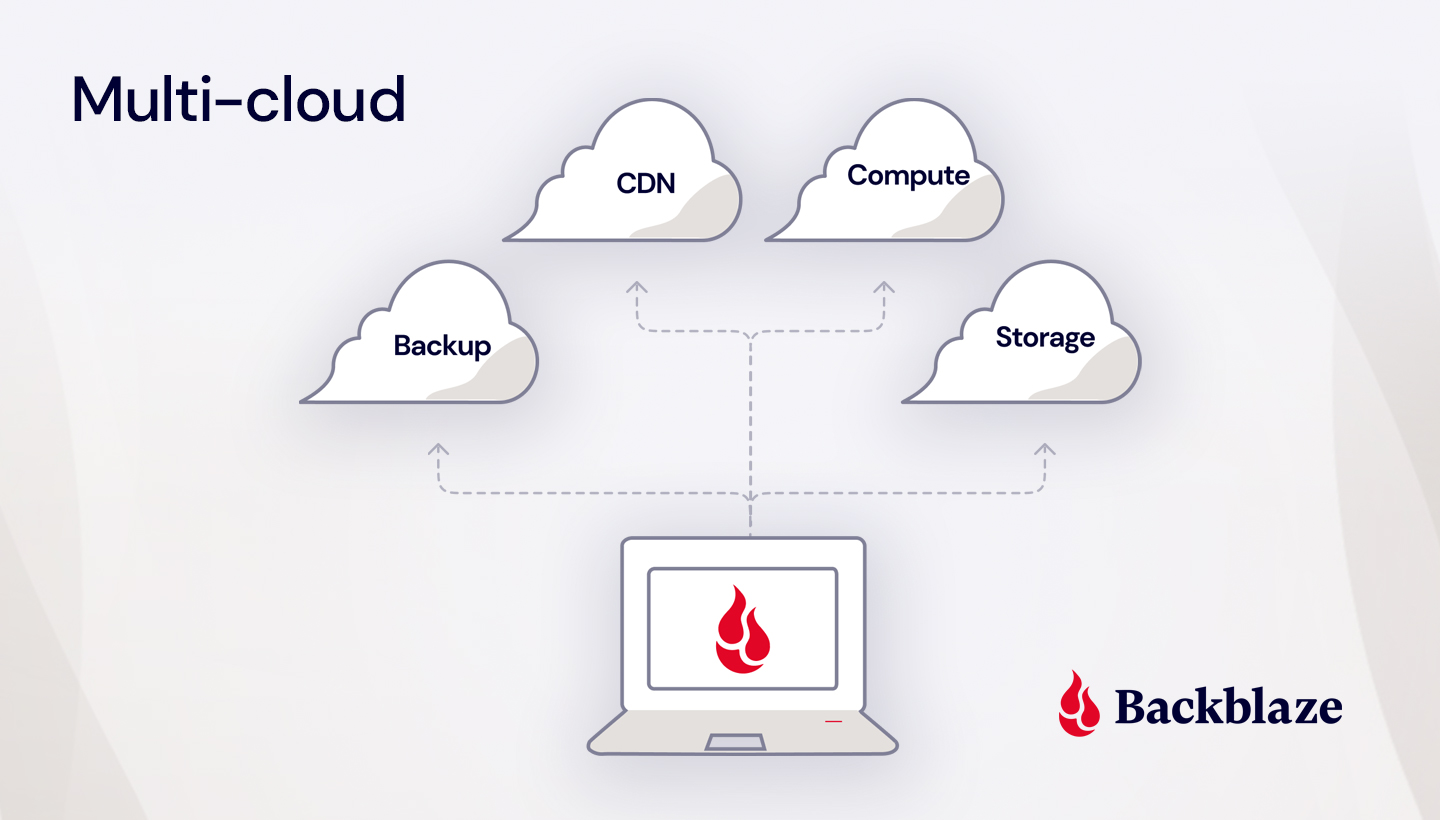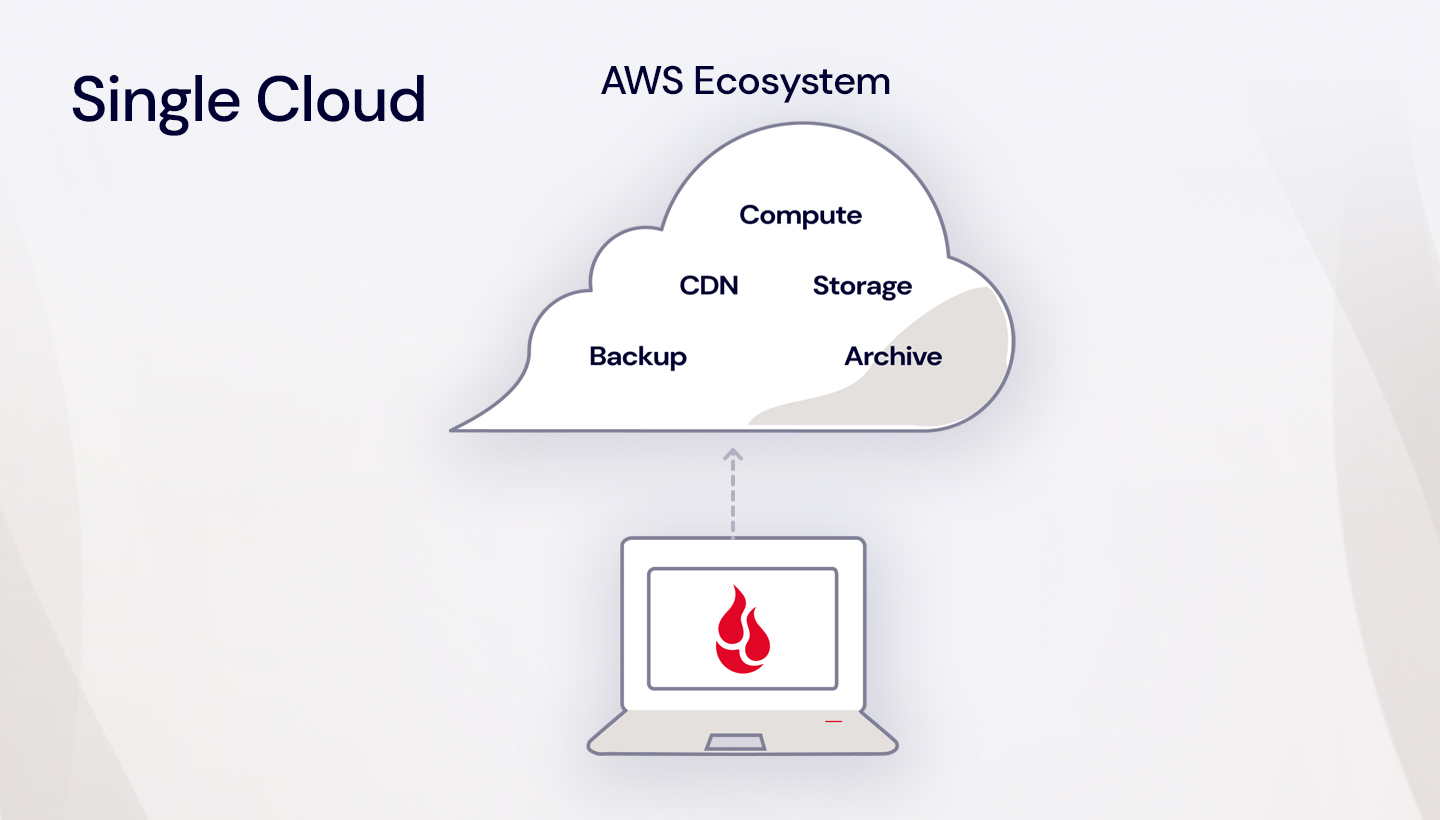Post Syndicated from Molly Clancy original https://www.backblaze.com/blog/multi-cloud-strategy-architecture-guide/

Cloud technology transformed the way IT departments operate over the past decade and a half. A 2020 survey by IDG found that 81% of organizations have at least one application or a portion of their computing infrastructure in the cloud (up from 51% in 2011) and 55% of organizations currently use more than one cloud provider in a multi-cloud strategy.
Deploying a multi-cloud approach doesn’t have to be complicated—“multi-cloud” simply means using two or more different cloud providers and leveraging their advantages to suit your needs. This approach provides an alternative to relying on one cloud provider or on-premises infrastructure to handle everything.
If you’re among the 45% of organizations not yet using a multi-cloud approach, or if you want to get more out of your multi-cloud strategy, this post explains what multi-cloud is, how it works, the benefits it offers, and considerations to keep in mind when rolling out a multi-cloud strategy.
First, Some Multi-cloud History
The shift to multi-cloud infrastructure over the past decade and a half can be traced to two trends in the cloud computing landscape. First, AWS, Google, and Microsoft—otherwise known as the “Big Three”—are no longer the only options for IT departments looking to move to the cloud. Since AWS launched in 2006, specialized infrastructure as a service (IaaS) providers have emerged to challenge the Big Three, giving companies more options for cloud deployments.
Second, many companies spent the decade after AWS’s launch making the transition from on-premises to the cloud. Now, new companies launching today are built to be cloud native and existing companies are poised to optimize their cloud deployments. They’ve crossed the hurdle of moving on-premises infrastructure to the cloud and can focus on how to architect their cloud environments to maximize the advantages of multi-cloud.
What Is Multi-cloud?
Nearly every software as a service (SaaS) platform is hosted in the cloud. So, if your company uses a tool like OneDrive or Google Workspace along with any other cloud service or platform, you’re technically operating in a “multi-cloud” environment. But using more than one SaaS platform does not constitute a true multi-cloud strategy.
To narrow the definition, when we in the cloud services industry say “multi-cloud,” we mean the public cloud platforms you use to architect your company’s infrastructure, including storage, networking, and compute.

By this definition, multi-cloud means using two different public IaaS providers rather than keeping all of your data in one diversified cloud provider like AWS or Google or using only on-premises infrastructure.

Multi-cloud vs. Hybrid Cloud: What’s the Diff?
Multi-cloud refers to using more than one public cloud platform. Hybrid cloud refers to the combination of a private cloud with a public cloud. A private cloud is typically hosted on on-premises infrastructure, but can be hosted by a third party. The key difference between a private and public cloud is that the infrastructure, hardware, and software for a private cloud are maintained on a private network used exclusively by your business or organization.
Adding to the complexity, a company that uses a private cloud combined with more than one public cloud is really killing it with their cloud game using a hybrid multi-cloud strategy. It can all get pretty confusing, so stay tuned for a follow-up post that focuses solely on this topic.
How to Implement Multi-cloud: Use Cases
Companies operate multi-cloud environments for a variety of reasons. For some companies, the adoption of multi-cloud may have initially been an unintentional result of shadow IT—when separate departments adopt cloud services without engaging IT teams for assistance. As these deployments became integral to operations, IT teams likely incorporated them into an overall enterprise cloud strategy. For others, multi-cloud strategies are deployed intentionally given their suitability for specific business requirements.
So, how do you actually use a multi-cloud strategy, and what is a multi-cloud strategy good for? Multi-cloud has a number of compelling use cases and rationales, including:
- Disaster recovery.
- Failover.
- Cost optimization.
- Avoiding vendor lock-in.
- Data sovereignty.
- Access to specialized services.
Disaster Recovery
One of the biggest advantages of operating a multi-cloud environment is to achieve redundancy and plan for disaster recovery in a cloud-native deployment. Using multiple clouds helps IT departments implement a modern 3-2-1 backup strategy with three copies of their data, stored on two different types of media, with one stored off-site. When 3-2-1 evolved, it implied the other two copies were kept on-premises for fast recoveries.
As cloud services improved, the need for an on-premises backup shifted. Data can now be recovered nearly as quickly from a cloud as from on-premises infrastructure, and many companies no longer use physical infrastructure at all. For companies that want to be or already are cloud-native, keeping data in multiple public clouds reduces the risk one runs when keeping both production and backup copies with one provider. In the event of a disaster or ransomware attack, the multi-cloud user can restore data stored in their other, separate cloud environment, ideally one that offers tools like Object Lock to protect data with immutability.
Failover
Similarly, some cloud-native companies utilize multiple cloud providers to host mirrored copies of their active production data. If one of their public clouds suffers an outage, they have mechanisms in place to direct their applications to failover to a second public cloud.
E-commerce company, Big Cartel, pursued this strategy after AWS suffered a number of outages in past years that gave Big Cartel cause for concern. They host more than one million websites on behalf of their clients, and an outage would take them all down. “Having a single storage provider was a single point of failure that we grew less and less comfortable with over time,” Big Cartel Technical Director, Lee Jensen, acknowledged. Now, their data is stored in two public clouds—Amazon S3 and Backblaze B2 Cloud Storage. Their content delivery network (CDN), Fastly, preferentially pulls data from Backblaze B2 with Amazon S3 as failover.

Cost Optimization
Challenger companies can offer incentives that compete with the Big Three and pricing structures that suit specialized data use cases. For example, some cloud providers offer free egress but put limits on how much data can be downloaded, while others charge nominal egress fees, but don’t cap downloads. Savvy companies employ multiple clouds for different types of data depending on how much data they have and how often it needs to be accessed.
SIMMER.io, a community site that makes sharing Unity WebGL games easy for indie game developers, would get hit with egress spikes from Amazon S3 whenever one of their hosted games went viral. The fees turned their success into a growth inhibitor. SIMMER.io mirrored their data to Backblaze B2 Cloud Storage and reduced egress to $0 as a result of the Bandwidth Alliance partnership between Backblaze and Cloudflare. They can grow their site without having to worry about increasing egress costs over time or usage spikes when games go viral, and they doubled redundancy in the process.

Avoiding Vendor Lock-in
Many companies initially adopted one of the Big Three because they were the only game in town, but later felt restricted by their closed systems. Companies like Amazon and Google don’t play nice with each other and both seek to lock customers in with proprietary services. Adopting a multi-cloud infrastructure with interoperable providers gives these companies more negotiating power and control over their cloud deployments.
For example, Gideo, a connected TV app platform, initially used an all-in-one cloud provider for compute, storage, and content delivery, but felt they had no leverage to reduce their bills or improve the service they were receiving. They adopted a multi-cloud approach, building a tech stack with a mix of unconflicted partners where they no longer feel beholden to one provider.
Data Sovereignty
Many countries, as well as the European Union, have passed laws that regulate where and how data can be stored. Companies subject to these data residency standards may employ a multi-cloud approach to ensure their data meets regulatory requirements. They use multiple public cloud providers with different geographic footprints in locations where data must be stored.
Access to Specialized Services
Organizations may use different cloud providers to access specialized or complimentary services. For example, a company may use a public cloud like Vultr for access to compute resources or bare metal servers, but store their data with a different, interoperable public cloud that specializes in storage. Or a company may use a cloud storage provider in combination with a cloud CDN to distribute content faster to end users.
The Advantages of Multi-cloud Infrastructure
No matter the use case or rationale, companies achieve a number of advantages from deploying a multi-cloud infrastructure, including:
- Better Reliability and Lower Latency: In a failover scenario, if one cloud goes down, companies with a multi-cloud strategy have others to fall back on. If a company uses multiple clouds for data sovereignty or in combination with a CDN, they see reduced latency as their clouds are located closer to end users.
- Redundancy: With data in multiple, isolated clouds, companies are better protected from threats. If cybercriminals are able to access one set of data, companies are more likely to recover if they can restore from a second cloud environment that operates on a separate network.
- More Freedom and Flexibility: With a multi-cloud system, if something’s not working or if costs start to become unmanageable, companies have more leverage to influence changes and the ability to leave if another vendor offers better features or more affordable pricing. Businesses can also take advantage of industry partnerships to build flexible, cloud-agnostic tech stacks using best-of-breed providers.
- Affordability: It may seem counterintuitive that using more clouds would cost less, but it’s true. Diversified cloud providers like AWS make their services hard to quit for a reason—when you can’t leave, they can charge you whatever they want. A multi-cloud system allows you to take advantage of competitive pricing among platforms.
- Best-of-breed Services: Adopting a multi-cloud strategy means you can work with providers who specialize in doing one thing really well rather than doing all things middlingly. Cloud platforms specialize to offer customers top-of-the-line service, features, and support rather than providing a one-size-fits all solution.
The Challenges of Multi-cloud Infrastructure
The advantages of a multi-cloud system have attracted an increasing number of companies, but it’s not without challenges. Controlling costs, data security, and governance were named in the top five challenges in the IDG study. That’s why it’s all the more important to consider your cloud infrastructure early on, follow best practices, and plan ways to manage eventualities.

Multi-cloud Best Practices
As you plan your multi-cloud strategy, keep the following considerations in mind:
- Deployment strategies.
- Cost management.
- Data security.
- Governance.
Multi-cloud Deployment Strategies
There are likely as many ways to deploy a multi-cloud strategy as there are companies using a multi-cloud strategy. But, they generally fall into two broader categories—redundant or distributed.
In a redundant deployment, data is mirrored in more than one cloud environment, for example, for failover or disaster recovery. Companies that use a multi-cloud approach rather than a hybrid approach to store backup data are using a redundant multi-cloud deployment strategy. Most IT teams looking to use a multi-cloud approach to back up company data or environments will fall into this category.
A distributed deployment model more often applies to software development teams. In a distributed deployment, different workloads or different components of the same application are spread across multiple cloud computing environments based on the best fit. For example, a DevOps team might host their compute infrastructure in one public cloud and storage in another.
Your business requirements will dictate which type of deployment you should use. Knowing your deployment approach from the outset can help you pick providers with the right mix of services and billing structures for your multi-cloud strategy.
Multi-cloud Cost Management
Cost management of cloud environments is a challenge every company will face even if you choose to stay with one provider—so much so that companies make cloud optimization their whole business model. Set up a process to track your cloud utilization and spend, and seek out cloud providers that offer straightforward, transparent pricing to make budgeting simpler.
Multi-cloud Data Security
Security risks increase as your cloud environment becomes more complex. There are more attack surfaces, and you’ll want to plan security measures accordingly. To take advantage of multi-cloud benefits while reducing risk, follow multi-cloud security best practices:
- Ensure you have controls in place for authentication across platforms. Your different cloud providers likely have different authentication protocols, and you need a framework and security protocols that work across providers.
- Train your team appropriately to identify cybersecurity risks.
- Stay up to date on security patches. Each cloud provider will publish their own upgrades and patches. Make sure to automate upgrades as much as possible.
- Consider using a tool like Object Lock to protect data with immutability. Object Lock allows you to store objects using a Write Once, Read Many (WORM) model, meaning after it’s written, data cannot be modified or deleted for a defined period of time. Any attempts to manipulate, copy, encrypt, change, or delete the file will fail during that time. The files may be accessed, but no one can change them, including the file owner or whoever set the Object Lock.
Multi-cloud Governance
As cloud adoption grows across your company, you’ll need to have clear protocols for how your infrastructure is managed. Consider creating standard operating procedures for cloud platform management and provisioning to avoid shadow IT proliferation. And set up policies for centralized security monitoring.
Ready for Multi-cloud? Migration Strategies
If you’re ready to go multi-cloud, you’re probably wondering how to get your data from your on-premises infrastructure to the cloud or from one cloud to another. After choosing a provider that fits your needs, you can start planning your data migration. There are a range of tools for moving your data, but when it comes to moving between cloud services, a tool like our Cloud to Cloud Migration can help make things a lot easier and faster.
Have any more questions about multi-cloud or cloud migration? Let us know in the comments.
The post Multi-cloud Architecture Guide appeared first on Backblaze Blog | Cloud Storage & Cloud Backup.